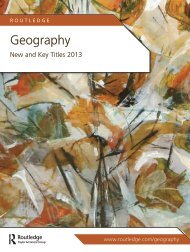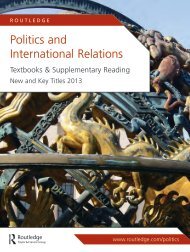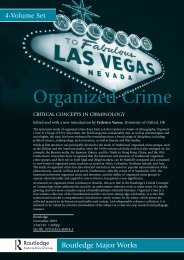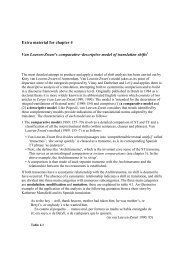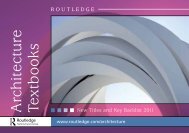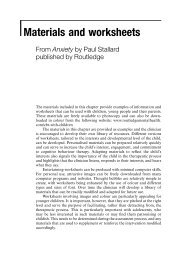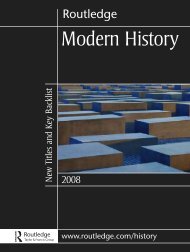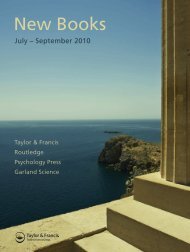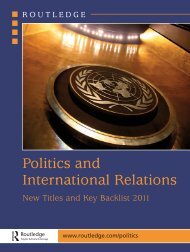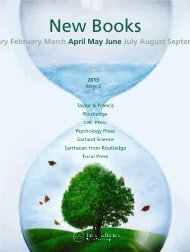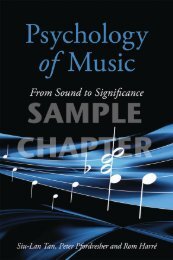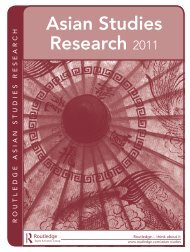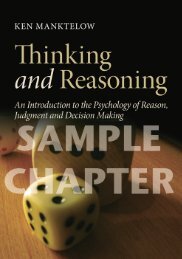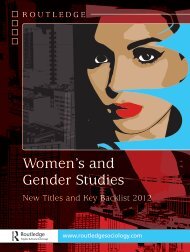Tim Burton: The Monster and the Crowd - A Post-Jungian Perspective
Tim Burton: The Monster and the Crowd - A Post-Jungian Perspective
Tim Burton: The Monster and the Crowd - A Post-Jungian Perspective
You also want an ePaper? Increase the reach of your titles
YUMPU automatically turns print PDFs into web optimized ePapers that Google loves.
20 Introduction<br />
veil of realism ± on <strong>the</strong> contrary, <strong>the</strong>ir structure <strong>and</strong> function are always<br />
accessible, non-elitist <strong>and</strong> interpretable. <strong>The</strong> non-realistic modes (<strong>the</strong> fantastic,<br />
<strong>the</strong> uncanny <strong>and</strong> <strong>the</strong> marvellous, to use Tzvetan Todorov's terminology),<br />
however, can be very complex too ± in <strong>the</strong>ir own way. Juxtaposed<br />
with <strong>the</strong> reality plane (think of <strong>the</strong> cinematic <strong>and</strong> ®ctional magical realism) 5 ,<br />
instead of `mythologising' <strong>and</strong> simplifying <strong>the</strong> narrative, <strong>the</strong>y make it more<br />
intricate. <strong>The</strong> non-realistic plane of a magical-realist narrative sequence<br />
points at <strong>the</strong> convergences <strong>and</strong> divergences between <strong>the</strong> psychological <strong>and</strong><br />
<strong>the</strong> real, <strong>and</strong> at <strong>the</strong> discrepancies between <strong>the</strong> inner <strong>and</strong> <strong>the</strong> outer worlds.<br />
Magical realism contains hidden niches which can be occupied by political<br />
statements, its `magical' part serving as a safe place for political allegories.<br />
Magic can be presented in <strong>the</strong> narrative `as a cultural corrective, requiring<br />
readers to scrutinize accepted realistic conventions of causality, materiality,<br />
motivation' (Faris <strong>and</strong> Zamora, 1995: 3).<br />
Splitting <strong>the</strong> narrative into two planes is, by all means, a very attractive<br />
<strong>and</strong> effective stylistic device; it `externalises' <strong>the</strong> character's psychic life,<br />
displays <strong>the</strong> dialectical intricacies of human relationships <strong>and</strong> even <strong>the</strong><br />
transitoriness <strong>and</strong> subjectivity of commonly accepted, <strong>and</strong> seemingly `real',<br />
discourses. While most of <strong>Burton</strong>'s ®lms, to some extent, concern <strong>the</strong> clash<br />
between <strong>the</strong> real <strong>and</strong> <strong>the</strong> psychological, he used magical realism to its<br />
maximum potential only once ± in Big Fish (2003), which boasts a ra<strong>the</strong>r<br />
convoluted storyline.<br />
By his own admission, <strong>Burton</strong> is totally at sea with narrative sequences,<br />
especially of such an elaborate kind. It is also unusual for him to employ<br />
novels as canvases for his vision. A good, <strong>and</strong> ornate, storyline is more of a<br />
Steven Spielberg thing, so it is not surprising that Spielberg was also<br />
interested in making <strong>The</strong> Big Fish (Le Blanc <strong>and</strong> Odell, 2005: 121). It is far<br />
more curious that <strong>Burton</strong> chose it as working material for his next ®lm, for,<br />
although <strong>the</strong>matically <strong>the</strong> story lies within <strong>Burton</strong>'s usual pool of archetypal<br />
schemata (death of <strong>the</strong> fa<strong>the</strong>r, hero myth, a bewitching anima), stylistically it<br />
differs from <strong>the</strong> bulk of his work. <strong>The</strong> biggest observable difference is <strong>the</strong><br />
presence of <strong>the</strong> perceivable `reality plane' in Big Fish. Le Blanc <strong>and</strong> Odell<br />
note that <strong>the</strong> ®lm, because of its `grounding in <strong>the</strong> real world, <strong>and</strong> not <strong>the</strong><br />
idealised pastel pseudo-1950s of Edward Scissorh<strong>and</strong>s or <strong>the</strong> imposing<br />
futuristic megapolis of Batman', feels `strangely dissociated' (2005: 124).<br />
Such narrative complexity is ra<strong>the</strong>r untypical for <strong>Burton</strong> <strong>and</strong> can be credited<br />
to <strong>the</strong> fact that it had pre-existed as a fully ¯edged magical realist novel.<br />
Although a story about a man's ®nal reconciliation with his fa<strong>the</strong>r may be<br />
a good way of expressing existential angst, <strong>Burton</strong> seems to be more at<br />
home with purely grotesque structures: fairy tales (Edward Scissorh<strong>and</strong>s,<br />
5 Cinematic examples: Being John Malkovich (1999), Pan's Labyrinth (2006); literary examples:<br />
Mikhail Bulgakov's Master <strong>and</strong> Margarita (1928±1940), <strong>The</strong> Magus (1966) by John Fowles.<br />
http://www.jungarena.com/tim-burton-<strong>the</strong>-monster-<strong>and</strong>-<strong>the</strong>-crowd-9780415489713



